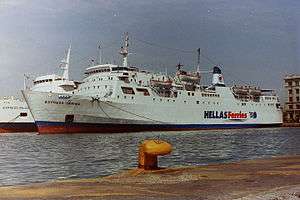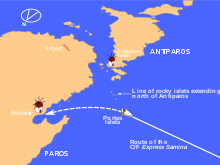MS Express Samina
MS Express Samina (Greek: Εξπρές Σαμίνα) was a French-built RoPax ferry that collided with a rock off the coast of Paros island in the central Aegean Sea on 26 September 2000. The accident resulted in 81 deaths[3] and the loss of the ship. The cause of the accident was crew negligence, for which several members were found criminally liable.
 Express Samina in Piraeus, July 2000 | |
| History | |
|---|---|
| Name: |
|
| Owner: | |
| Operator: | |
| Port of registry: | |
| Builder: |
|
| Yard number: | F23[2] |
| In service: | 25 June 1966[2] |
| Out of service: | 26 September 2000[2] |
| Identification: | IMO number: 6613548[2] |
| Fate: | Hit rocks and sank off the coast of Paros island, 26 September 2000[2] |
| Notes: | Sister ship of MS Express Naias |
| General characteristics [2] | |
| Tonnage: | |
| Length: | 115.00 m (377 ft 4 in) |
| Beam: | 18.11 m (59 ft 5 in) |
| Draught: | 4.36 m (14 ft 4 in) |
| Decks: | 11 |
| Installed power: | 2 × Atlantique–Pielstick 16c (10,945 kW) |
| Speed: | 21 knots (39 km/h; 24 mph) |
| Capacity: |
|
Ship history
The ship was built as MS Corse in 1966 at Chantiers de l'Atlantique, St Nazaire, France[2] for Compagnie Générale Transatlantique, along with her sister ship MS Comte De Nice. In 1969, she was transferred to Compagnie Générale Transméditerranéenne. After six years of service, the company changed its name again, to SNCM, to which she was transferred. She sailed from France for the last time in 1982, as she was sold to a Greek company, Stability Maritime, to operate their Italy–Greece–Israel route under her new name MS Golden Vergina.[1] In 1988, she was sold to the Agapitos Bros for service in the Aegean sea under Agapitos Lines, without a name change. She was then sold in 1999 to Minoan Flying Dolphins, again for service in the Aegean, when she was renamed Express Samina.
Disaster

On the evening of Tuesday 26 September 2000, MS Express Samina left the Port of Piraeus with 473 passengers and 61 crew members. At 22:12 local time (20:12 UTC), 2 nmi off the port of Parikia, Paros, the ship hit the reef of Portes islets[4] at 18 knots. The wind at the time was 8 on the Beaufort scale. The ship sank close to the islets at 23:02, resulting in the deaths of 82 people from a total of 533 on board. The first responders to the distress call were fishing boats from the nearby port, followed by the port authorities and Royal Navy vessels, which were in the area carrying out a NATO exercise.[5] The fact that some of the crew did not help the passengers evacuate the sinking ferry contributed to the death toll.[4]
The crew had placed the ship on autopilot and there were no crew members watching the ship. Even with autopilot on, standard practice calls for one crew member to watch the controls, for example to avoid collisions with other vessels. The crew had deployed the fin stabilizers system to decrease the motions in bad weather; normally both stabilizer fins would deploy, but in this case the port stabilizer fin failed to extend, causing the ship to drift and therefore not travel in a straight line. A crew member discovered the problem and tried to steer the ship to port, but this action occurred too late and at 22:12 local time (20:12 UTC), the ship struck the east face of the taller Portes pinnacle. The rocks tore a six-meter long and one-meter wide hole above the water line. After the impact, the rocks bent the stabilizer fin backwards, and the fin cut through the side of the hull, below the waterline and next to the engine room. The water from the three-meter gash destroyed the main generators and cut off electrical power. The water spread beyond the engine room, and the operators could not remotely shut the doors due to a lack of electrical power.
Professor David Molyneaux, a ship safety expert, said that the damage sustained by the MS Express Samina should not normally sink such a ship. The ship sank because nine of its eleven watertight compartment doors were open even though safety laws require ship operators to close and lock the safety doors. Molyneaux described the open watertight doors as the most significant aspect of the sinking.[6]
Chronology of the sinking
At 22:15 local time (20:15 UTC), three minutes after impact, the ship was listing by five degrees to starboard. By 22:25, the list had increased to fourteen degrees and water began to enter the ship through the six-meter gash. By 22:29, the ship was listing by twenty-three degrees, preventing the launching of additional lifeboats; only three of the eight lifeboats were deployed. At 22:32 the ship had listed by 33 degrees, and by 22:50 the ship lay on its side. The clock on the bridge stopped at 11:02, which the authorities took to be an indication of the time at which the ship sank. The degree of damage, the scenario, and the open vehicle deck space in RORO ferry design were all factors that led to the sinking.[6][7]
Aftermath
The port-master of Parikia, Dimitris Malamas, died the same night from a heart attack due to the stress of the evacuation operations.[6]
As a result of the sinking, ferries were retired after 30 years, instead of 35, under Greece's new laws precipitated by the disaster. These laws were eventually relaxed due to the aging Greek fleet, but ships over 30 years old must comply with strict safety standards, and regular inspections are carried out by authorities. Additionally, this hastened the adoption of voyage recorders, the equivalent of black boxes for ships; all passenger ferries are now required by law to contain voyage recorders.[6]
On 29 November 2000, Pandelis Sfinias (Παντελής Σφηνιάς) the manager of the company Minoan Flying Dolphins, committed suicide by jumping from his sixth floor office window.[8] He had been charged with criminal negligence in conjunction with this ferry disaster, and had been the focus of much media attention. A subsequent coroner's report revealed alcohol and antidepressants in his system at the time of his death. There was no note, but media reports hinted at a possible call made before he jumped. Several crew members, as well as representatives for the owners, were subsequently charged with different criminal charges, including manslaughter and negligence. The trial commenced in late July 2005.
First officer Tassos Psychoyios was sentenced to 19 years, while Captain Vassilis Giannakis received a 16-year sentence. Psychoyios had been watching a football match on television when the ship hit the rocks, according to witnesses. Three crew members were sentenced to between 15 months and 8 years 9 months for a series of misdemeanours that included abandoning ship without the captain's permission.[9]
The City of Seattle honoured 26-year-old Heidi Hart and 32-year-old Christine Shannon, two American passengers, for heroism during the disaster. The women had rescued two men.[6][10]
In popular culture
The disaster was featured in "Collision Course", a Season 3 (2005) Crash Scene Investigation episode of the Canadian TV series Mayday[6] For broadcasters that do not use the series name Mayday, this is one of three Season 3 episodes labeled as Crash Scene Investigation spin-offs, examining marine or rail disasters. The dramatisation was broadcast with the title "Express Samina" in the United Kingdom, Australia and Asia.
The two American passengers, Heidi Hart and Christine Shannon, were interviewed for an episode of the Biography Channel series I Survived.... The story of Hart, Shannon, and the MS Express Samina was featured in episode 141 of the true crime podcast My Favorite Murder, titled "Big Thirsty Robe".
See also
- List of RORO vessel accidents
- SS Heimara
- SS Heraklion
- MS Sea Diamond, a cruise ship which ran aground and sank off the coast of Santorini, Greece
- Costa Concordia, a cruise ship which ran aground and capsized at Isola del Giglio, Italy
References
- Lulurgas, Michele. "F/B GOLDEN VERGINA'". ADRIATIC AND AEGEAN FERRIES. Retrieved 28 September 2008.
- Asklander, Micke. "M/S Corse (1966)". Fakta om Fartyg (in Swedish). Retrieved 28 September 2008.
- "Time Machine: Express Samina, 15 years since tragedy that left 81 dead (in Greek)". www.news247.gr. 27 September 2015. Retrieved 2 October 2016.
- Poffley, Frewin (2005). "Ferry Disaster off Paros". www.greekislandhopping.com. Archived from the original on 31 March 2011. Retrieved 2 April 2011.
- "Greek ferry captain arrested as death toll hits 62". The Guardian. 27 September 2000. Retrieved 19 March 2018.
- "Collision Course". Mayday. Season 3. Episode 11. 2005. Discovery Channel Canada / National Geographic Channel.
- "British women escaped, only to be shipwrecked again minutes later". The Independent. 27 September 2000. Retrieved 18 September 2008.
- The rough guide to the Greek islands – 5th Edition by Lance Chilton, Marc Dubin, Mark Ellingham (ISBN 184353259X 22 June 2004)
- "Samina crew receive long prison terms". ekathimerini.com. 28 February 2006. Retrieved 12 April 2011.
- Vlahou, Toula (16 October 2000). "Spared by the Sea". People. Vol. 54 no. 16. Archived from the original on 3 June 2009.
